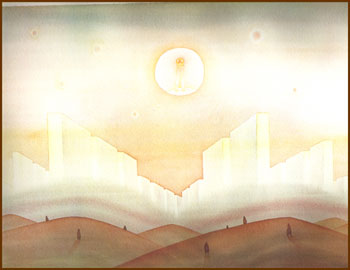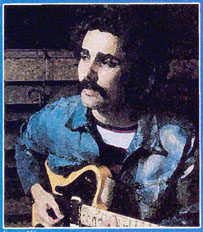|
I suppose that when you've chosen
a particular tune to open any recording, it must obviously represent
something important about the project as a whole. For me, "Daily
Bulls" was just such a piece. It had the fire, the energy,
and the aggressiveness which embodied the musical direction in which
I had hoped I was headed. Again, we're talking about 1978! Though
far too many years have passed, I do believe, with some minor changes
and adjustments, this tune could be performed, and would function well,
especially with a Latin jazz treatment. The lead sheet/mini-score with
which you are now presented has been revised to better match the recorded
performance. In reviewing all my old lead sheets from those sessions,
I'm realizing just how many structural changes were made during
the process of recording. This only means one thing, that my good friends,
my fellow musicians: Don Grolnick; Jeff Mironov; Will
Lee; Steve Gadd; and Ralph MacDonald must have all
made suggestions which contributed to making this a better piece of
music than my ideas alone had envisioned. On each recording, I had always
hoped to have at least one tune which featured the mounted cowbell work
of Steve Gadd, which was always special and unique to him at that time. And so, on "THE BLUE MAN," this tune became that vehicle.
It now seems obvious to me that "Daily
Bulls" was written in part at the guitar, and the Fender Rhodes
as well. The guitar melodies at [A] and [B] were obviously
written on the guitar. However, the melody at [C] was more a
case of something I sang to myself, and then later harmonized in the
manner in which you now hear it. Though in those years I don't
believe that I had made as detailed a study of the keyboard harmonies
of Clare Fischer, the piano voicings you see throughout this
tune demonstrate a love for that style, his style. The clustered voicings
which appear in [I] are all in this style and performed beautifully
by the touch of Don Grolnick. However, the melody at [C] was more a
case of something I sang to myself, and then later harmonized in the
manner in which you now hear it. Though in those years I don't
believe that I had made as detailed a study of the keyboard harmonies
of Clare Fischer, the piano voicings you see throughout this
tune demonstrate a love for that style, his style. The clustered voicings
which appear in [I] are all in this style and performed beautifully
by the touch of Don Grolnick.
I think, were I to attempt to perform
this tune today, first amongst the things I would change is the bass
line. As a matter of fact, Will adjusted the original written bass line
anyway by making a subtle change on beat 4 of the 2nd bar. However,
today that bass line would become more of a Latin bass tumbao, and would
observe all the chord changes rather than existing as a pedal-point
beneath the changing harmonies. The keyboard part could certainly remain
the same, in the right-hand, as it marks and colors the guitar melody.
In letter [B], though the piano voicings go by quickly, I know I spent
a great deal of time making certain that they colored the guitar melody
in a particular way. I would have to say that these harmonies were more
influenced by the acoustic piano styles of Chick Corea; McCoy
Tyner; and Herbie Hancock.
When we arrive at letter [C], were
it not for Steve Gadd's active drum rhythms, the tune might have
come to a grinding halt because of the whole-note rhythms I wrote for
Will Lee. I am certain that if I had just told him to "play what
feels right to you," he would have played something much better
than what I wrote. Melodically speaking, [C] is really a very cantabile, singable, piece of writing, and when one is talking about the guitar music of those years, that was sadly a rare thing.
As the tune hits letter [D], which
begins the guitar solo, you now see a written bass line more reflective
of how Will interpreted what I had written, and what he played was much,
much better, more natural. As a matter of fact, when we arrived at [D2]
he had even added more of his own personality to it. The guitar solo,
at [E], is open-ended and was designed to be played over a G-pedal, still essentially
a Gm/Dorian sonority but I was hoping that it would provide a great
deal of harmonic freedom. I don't know that this approach is what
I would do today, and perhaps both solo sections would observe the actual
'changes' which appear in [A]. After the guitar solo, when the 'cue' is given, we begin
to see some interesting changes in form, which probably came about as
a result of good communication between all the players. So, at [B2]
you will see that we only played it twice(2x) as opposed to the 3x it
was played when it first appeared(Pg. 2). From here, the tune moves
to [C2], and again the section was shortened to keep the piece
moving forward. To accomplish this, we eliminated the 1st-ending and
went directly to the 2nd-ending, moving ahead and bringing us to [D2]
and a brief conga solo by Ralph MacDonald, setting-up Don Grolnick's
brilliant and very special Hammond B-3 organ solo.
Don's organ solo, [F], which
does observe the changes from both [I] or [A], is one
of my favorite moments on this recording, and in truth, on ANY of my
recordings! What a very special player he was, with his own blending
of jazz, funk, and R&B elements! When Don gives the 'cue'
that his solo is about to end, we took the 2nd-ending, and then a D.S.
back to [A], on Pg. 1; from there we played [B] using
both the 1st and 2nd-endings, but taking the coda in the 2nd-ending
for the actual ending of the tune, the last bar on Pg. 5. As this ending
was not written on my original 3-page lead sheet, it leads me to believe
that, as a group, we made-up this particular ending as opposed to simply
fading on [B] which was probably my original plan. A very lazy
way out!!!
In prior editions at KHAN'S
KORNER, we've talked about the parts one hands out to their
fellow musicians for live gigs or recording, and I've said that
it's best if you can keep it down to 4 pages maximum. Well, the
original lead sheet/mini-score for "Daily Bulls" was only
3 pages long and I would imagine that all the players made many, many
marks with pencil to notate the changes we were making in the form.
So, though the lead sheet you now have observes all these changes and
has become 5 pages long. A single part, for any one of the instruments,
would still probably only be 3 pages, 4 pages for the keyboard perhaps.
However, for presentation here, it's important to share as much
information with you as is possible, and therefore the length is not
the most important consideration.
Though "THE BLUE MAN"
recording remains as one of my most popular, it is certainly flawed
by its sound. Mainly, as I've stated before, the fact that it is
"bottom light," meaning that there is not enough of a rich
bottom end from the electric bass and from the bass drum. This is totally
my fault and comes from my own lack of experience in mixing an album
in those days. Again, on the compilation, "THE COLLECTION,"
where I was allowed to be present for the remastering session, I tried
to 'help' the tracks from this LP by adding some bottom, and
taking off the shrill nature of the treble end of the recording. It
did seem to help a little on the CD version. However, though such EQ
changes are copiously notated during the mastering process, I am not
certain that the good people at Sony Music in Japan observed them when
remastering the three LPs for release as individual CDs for the first
time.
I have been asked on countless occasions, "What does this title, 'Daily Bulls' mean?" Of course, I have never had the answer to that. I only knew that it was the title of a watercolor painting by my dear friend, Jean-Michel Folon. Until his recent passing, I didn't even recall that I had a print of this painting in one of my books of his work. So, armed with my new scanner, we are now able to share the actual image, which bears the title, "Daily Bulls," with everyone. I would only say that whatever you see, this is what you make of it. I am certain that it is no easier to attach a title to a painting than it is to do so with a piece of music. I used to go to his exhibitions and just write down the titles for future usage with one of my tunes. And that is how this title became attached to this song. But, because of the Latin nature of the rhythms, and because of the word "bulls", I thought that putting them together would make sense. This, in a world that makes no sense at all!
As I view this piece of music today, I
think, that, with a little arranging help, it could function very well
in any Latin jazz group. But, with the mini-score now available everyone
is welcome to try it in their own way. Thanks so much for your visits
to KHAN'S KORNER 2; it's our pleasure to provide you
with the opportunity to view and have the written music to the recordings
which might reside in your collection. On a humorous note, perhaps because this piece is so very rooted in the 'fusion' style of those years, I still laugh when I recall a portion of a friend's "lyrics" to letter [B] of this tune. They went something like this: "Daily Bulls are not for me, I would rather climb a tree!" Try singing that! As Will Lee taught me, you've got to be able to laugh at yourself!
[Photo of Steve by David Gahr, colorized and digitized by Al Irizarry.]
|

